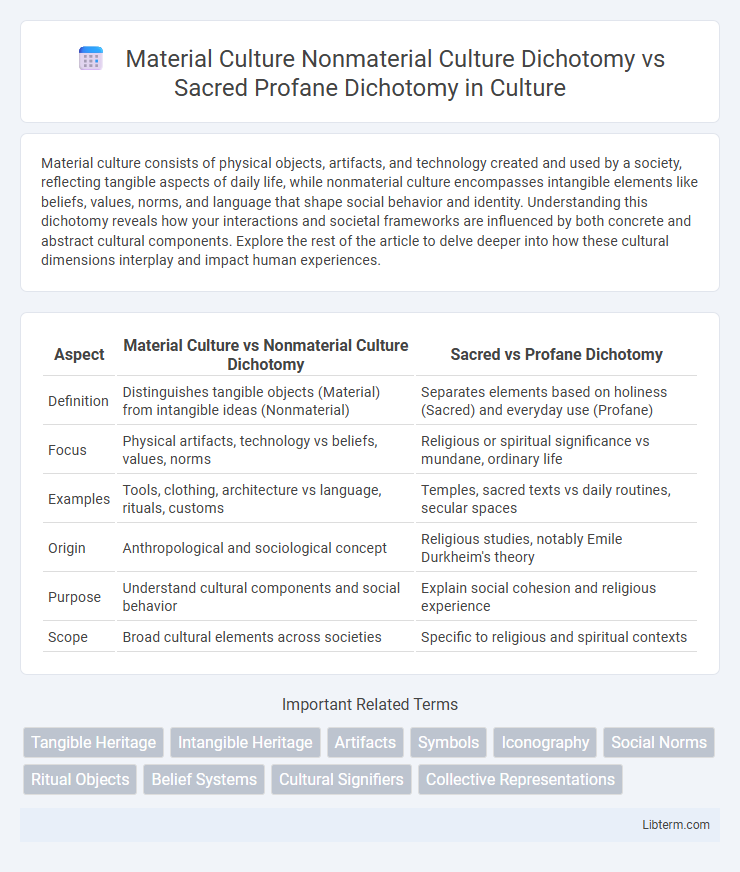Material culture consists of physical objects, artifacts, and technology created and used by a society, reflecting tangible aspects of daily life, while nonmaterial culture encompasses intangible elements like beliefs, values, norms, and language that shape social behavior and identity. Understanding this dichotomy reveals how your interactions and societal frameworks are influenced by both concrete and abstract cultural components. Explore the rest of the article to delve deeper into how these cultural dimensions interplay and impact human experiences.
Table of Comparison
| Aspect | Material Culture vs Nonmaterial Culture Dichotomy | Sacred vs Profane Dichotomy |
|---|---|---|
| Definition | Distinguishes tangible objects (Material) from intangible ideas (Nonmaterial) | Separates elements based on holiness (Sacred) and everyday use (Profane) |
| Focus | Physical artifacts, technology vs beliefs, values, norms | Religious or spiritual significance vs mundane, ordinary life |
| Examples | Tools, clothing, architecture vs language, rituals, customs | Temples, sacred texts vs daily routines, secular spaces |
| Origin | Anthropological and sociological concept | Religious studies, notably Emile Durkheim's theory |
| Purpose | Understand cultural components and social behavior | Explain social cohesion and religious experience |
| Scope | Broad cultural elements across societies | Specific to religious and spiritual contexts |
Understanding Material Culture: Definition and Examples
Material culture encompasses physical objects, artifacts, and technology that humans create and use, such as tools, clothing, and buildings, reflecting societal values and histories. Examples of material culture include ancient pottery, modern smartphones, and architectural landmarks, each embodying tangible aspects of cultural identity. Understanding material culture involves analyzing how these objects influence daily life, social practices, and cultural continuity within communities.
Nonmaterial Culture: Concepts and Characteristics
Nonmaterial culture encompasses intangible elements such as beliefs, values, norms, language, and customs that shape human behavior and social interaction. It differs from material culture by emphasizing symbolic meanings and cognitive frameworks rather than physical objects. Concepts within nonmaterial culture include ideologies, rituals, and social institutions, which collectively influence identity, cohesion, and cultural continuity.
The Material vs Nonmaterial Culture Dichotomy
The material vs nonmaterial culture dichotomy distinguishes between physical objects, artifacts, and tangible creations (material culture) and the intangible beliefs, values, norms, and symbols that shape human behavior (nonmaterial culture). Material culture provides concrete evidence of social practices, while nonmaterial culture forms the underlying cognitive and emotional frameworks guiding societal interactions. This dichotomy emphasizes the interconnectedness of objects and ideas in constructing cultural identity and social organization.
Sacred and Profane: Foundational Concepts in Sociology
Sacred and profane dichotomy, foundational in sociology, distinguishes elements set apart by society as extraordinary versus ordinary aspects of daily life. This concept, introduced by Emile Durkheim, highlights how sacred objects, rituals, and symbols foster social cohesion by embodying collective values and moral authority. In contrast to the material-nonmaterial culture dichotomy, sacred and profane focus specifically on the spiritual and symbolic dimensions that shape societal norms and community identity.
The Sacred-Profane Dichotomy: Historical Perspectives
The Sacred-Profane dichotomy, rooted in Emile Durkheim's foundational work, distinguishes between elements imbued with sacred meaning and those considered ordinary or profane within societies. Historically, this dichotomy has shaped anthropological and religious studies by emphasizing how sacred symbols and rituals create social cohesion and collective conscience. This perspective contrasts with the Material-Nonmaterial Culture dichotomy by focusing on the spiritual and symbolic dimensions rather than tangible artifacts and behaviors.
Comparing Culture Dichotomies: Material/Nonmaterial vs Sacred/Profane
Material culture encompasses tangible objects and artifacts, while nonmaterial culture includes beliefs, values, and norms, highlighting a dichotomy based on physical presence versus ideological content. In contrast, the sacred-profane dichotomy distinguishes cultural elements by their spiritual or profane significance, emphasizing the sanctity and ritual importance over materiality. Comparing these dichotomies reveals that material/nonmaterial culture differentiates based on physicality, whereas sacred/profane focuses on symbolic meaning and societal reverence.
Overlapping and Distinct Aspects of Both Dichotomies
Material culture and nonmaterial culture dichotomy emphasizes tangible versus intangible cultural elements, such as artifacts versus beliefs, while the sacred-profane dichotomy distinguishes between what is religiously revered and what is secular or everyday. Both dichotomies overlap in how material objects can become sacred symbols, intertwining tangible items with spiritual significance. Distinctly, the material-nonmaterial division centers on physicality and symbolism in culture, whereas the sacred-profane dichotomy focuses on the value and meaning assigned within religious contexts.
Sociological Theories Addressing Cultural Dichotomies
Sociological theories addressing cultural dichotomies emphasize the distinction between material culture, encompassing tangible artifacts and physical objects, and nonmaterial culture, which includes beliefs, values, and norms shaping social behavior. The Sacred-Profane dichotomy, introduced by Emile Durkheim, highlights the differentiation between elements regarded with reverence and those seen as ordinary or mundane, revealing how ritual and sacred symbols function to maintain social cohesion. Both dichotomies are pivotal in understanding cultural dynamics but operate on different analytical levels; material/nonmaterial dichotomy centers on cultural content, while sacred/profane dichotomy focuses on symbolic meanings and social functions within cultural systems.
Implications of Cultural Dichotomies in Modern Society
Cultural dichotomies such as the Material Culture vs Nonmaterial Culture and Sacred vs Profane distinctions shape modern societal values, influencing identity formation and social cohesion. Material culture emphasizes tangible artifacts and technology, while nonmaterial culture encompasses beliefs, customs, and norms, both essential for holistic cultural understanding and policy-making. The Sacred versus Profane dichotomy affects social rituals and moral frameworks, guiding ethical behavior and community boundaries in contemporary multicultural societies.
Rethinking Dichotomies: Toward an Integrated Cultural Framework
Rethinking dichotomies in cultural studies emphasizes bridging Material Culture and Nonmaterial Culture to capture the dynamic interplay between tangible artifacts and intangible beliefs. Integrating the Sacred-Profane dichotomy highlights how religious or symbolic meanings infuse objects and practices, challenging rigid separations. An integrated cultural framework promotes holistic analysis by recognizing the fluid boundaries where materiality and spirituality co-construct social realities.
Material Culture Nonmaterial Culture Dichotomy Infographic

 libterm.com
libterm.com